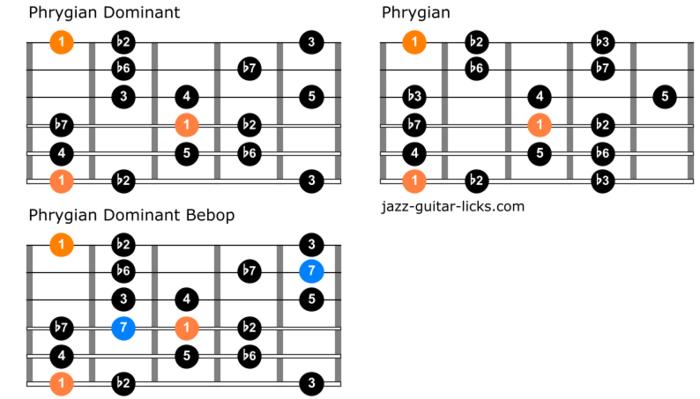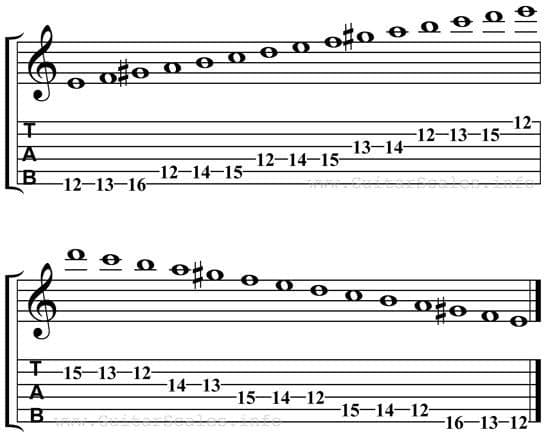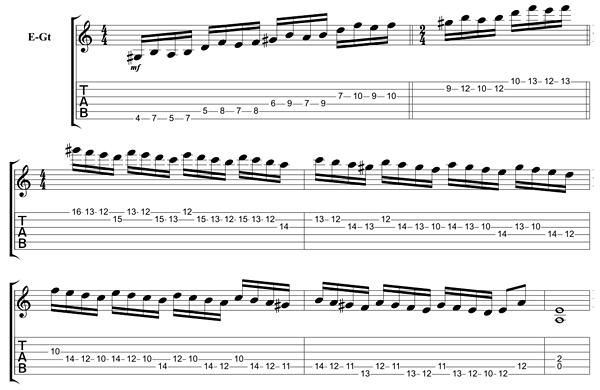Imagine standing before a packed auditorium, the stage lights ablaze. Your fingers graze the strings of your guitar, and with one swift pluck, you set forth a cascade of vibrant notes. An exotic sound fills the air, wrapping your audience in a timeless allure. — this is a scene I know well. As Robert Williams, I’ve lived this moment countless times, all thanks to the mesmerizing magic of the Phrygian Dominant scale guitar playing.
But I won’t jump to the finale just yet. This journey, from my first encounter with this scale to mastering its exotic melodies, plays out like a crescendo — a slow buildup to a compelling climax. Through the unfolding chapters of this guide, I will take you upon this riveting musically-rich odyssey.
Why am I so mesmerized by the Phrygian Dominant scale? Well, as per the research I’ve conducted during my years of indulging in exotic guitar scales, I found that an astonishing majority of guitarists overlook the Phrygian Dominant scale. Yet, it offers a whole realm of musical possibilities, a prodigious blend of Eastern sensibilities and Western complexities, capable of setting you apart on the stage.
Here’s a bold assertion: mastering the Phrygian Dominant scale can revolutionize your guitar playing. A wild claim, you might think, but that’s the allure. As with every beautiful melody, the mystery lies in its composition. Together, we will unravel this fascinating secret, exploring the intricacies of sound that rest within this profound scale.
I’ve traversed the uncharted territories of the Phrygian Dominant scale, braved its challenges, and emerged with a rich understanding of its alluring complexity. My personal experiences, formidable passion, and raw honesty frame this narrative. So let’s embark on this journey to mastering the enchanting soundscapes of the Phrygian Dominant scale on the guitar, one note at a time.
Understanding the Phrygian Dominant scale
Relation to other scales

As I delved into the world of guitar scales and modes during my time as a musician and while working as an editor for ‘Acoustic Guitar’, the intricate connections among various scales became increasingly clear to me. One such significant relation is that between the Phrygian Dominant scale and other scales, specifically the Harmonic Minor and Mixolydian scales, which I’d like to share with you.
Briefly, the Phrygian Dominant scale is the fifth mode of the Harmonic Minor scale, which implies that any harmonic minor scale has a corresponding Phrygian Dominant scale. For instance, an A Harmonic Minor scale shares the same notes as a D Phrygian Dominant scale, but starts on a different note. Understanding this relationship can help you see the “hidden” Phrygian Dominant scale within a Harmonic Minor one, expanding your potential for creating vibrant and unique sounds.
On the other hand, the similarities with the Mixolydian scale arise from their shared ‘dominant’ character, meaning that they both contain a major 3rd and a minor 7th. However, their tones and semitones are arranged differently, creating distinctly different sounds. Comprehending this nuance expands your grasp beyond the familiar landscape of major and minor modes into the terrain of ‘dominant’ modes, deepening your musical vocabulary.
Grasping these connections won’t just broaden your theoretical understanding; it will also have a practical impact on your music, as you’ll see in later sections about applying the Phrygian dominant scale in your compositions. These interscale relationships reveal the interconnected and versatile nature of music, where learning one scale can open doors to several others. I hope these insights help you explore and experiment on your journey of mastering the Phrygian Dominant scale on your guitar.
Learning to Play the Phrygian Dominant scale on Guitar

The first time I truly understood the Phrygian Dominant scale and its wild temperament, it felt as if I had stumbled upon a precious artifact, waiting to be unearthed. I was drawn in by its dark charm and the intriguing mix of notes the scale brings on the fretboard. It was a pivotal moment in my guitar playing journey. Today, as we delve into the depth of the Phrygian Dominant scale, my objective is not just to teach you the right notes to play but, more importantly, to extend my experiences, insights, and personal touch to inspire you in your own guitar odyssey.
Engulfed in the mysterious aura of the Phrygian Dominant scale, you’ll start your adventures on the fretboard. But how do we make those frets sing? My sincere offering is the careful assortment of guitar fretboard patterns, guitar scale shapes, and well-established guitar techniques, which, when woven together, makes learning this exotic scale a thrilling experience. Here’s how we’ll do it.
Understanding the Guitar Fretboard: Before we venture into learning the Phrygian Dominant scale positions, it’s important to get well-versed with your guitar fretboard. Use a fretboard chart to identify each note’s position on your guitar neck. This will familiarise you with the territory you are going to explore.
Distinguish the Phrygian Dominant scale notes: This is a variation of the Phrygian mode with a raised third, giving it an eastern, mystical flavor. Crucial to note here, map out the notes carefully on each string; a guitar tablature for the Phrygian Dominant scale can be incredibly helpful for this.
Master the scale shapes: Your journey becomes relatively straightforward once you start identifying the common shapes. Breathtakingly enough, each note’s freshness is evident when played in a different context, thus the same notes when used in an intricate pattern have the power to create an entirely different sonic entity.
Focus on technique: Right from posture to pick holding; everything matters. So while you practice your scale, be mindful of your technique. Especially with speed runs, you’d want to ensure your movements are minimal, efficient, and precise.
As we comprehend the different Phrygian Dominant scale positions, adopt a mindful approach to your practice. Allow yourself to feel each note’s characteristic and the emotion it stirs in you and around you. Over time, with consistent practice, you will notice how effortlessly your fingers glide over your fretboard chart, breathing life into the previously inanimate dots and lines.
The journey towards mastering the Phrygian Dominant scale is going to be fulfilling, both musically and personally. This is not a journey to rush through but to savor each moment. Remember, the magic of music unfolds with patience, practice, and perseverance.
As we move forward, making connections between the Phrygian Dominant scale and other scales you may already know would allow you to create inventively. Also, we’ll learn to apply the scale in our music and create some distinctive Phrygian Dominant licks. No matter where you find yourself in your musical journey, keep an open heart to learning, growing, and most importantly, enjoying the process.
Applying the Phrygian Dominant scale in your music
Creating Phrygian Dominant licks

Having mastered the Phrygian Dominant scale, let us carve out our own creative licks and enhance the musical compositions. Crafting ingenious, Phrygian Dominant licks is indeed one of my favorite elements of being a musician, it allows me to put my unique stamp on musical phrases and explore fascinating combinations of notes. Let’s plunge into this, adding fresh, exotic dimensions to our guitar solos.
Creating engaging licks involves exploring the scale and connecting notes in unexpected, captivating ways. Start simple, take the first, third, and fifth notes of the Phrygian Dominant scale and experiment with different sequences, timings, and phrasing. My tip is not to settle for the first idea that comes up; refine it, trial and error fashion, tweaking notes here and there, until you strike a lick that truly speaks to you.
A crucial aspect of my approach is to explore the dynamic range of the guitar. Playing licks at various positions on the fretboard opens up different tonal characteristics of the guitar, providing depth and richness to the licks. Always bear in mind the harmonic and melodic opportunities. Changing up the order of the notes, incorporating slides, bends, and vibrato techniques can breathe life into a simple lick.
While the Phrygian Dominant scale naturally has a tense, dramatic vibe, it’s also possible to create softer, wistful Phrygian Dominant licks. Consider using gentler picking techniques or a cleaner tone to create those more introspective licks. Remember, this is your musical canvas. Embody the freedom to color it with your own shades.
Another technique I cultivate is the usage of repeated motifs within my licks. A motif can be a small group of notes or a rhythmic pattern that you repeat throughout a lick but modify each time for interest. This provides continuity while permitting ample space for variance.
Lastly, don’t forget the value of rest. Experimentation with the rhythmic placement and duration of silence between notes could alter the impact of your licks dramatically, adding anticipation, and helping to shape the phrase.
In conclusion, creating Phrygian Dominant licks is a personal, creative process. It’s about finding those flavorful note sequences and infusing them with your own musicality. As much as it’s about knowing the technicalities and mastering the scale, it largely relies on intuition and personal feeling.
Join me in the next section, where we’ll delve a little deeper and explore the frequently asked questions about the Phrygian Dominant scale and how you can carry this knowledge forward to continually improve your daily guitar practice.
FAQs
What is the Phrygian Dominant Scale on Guitar?
How is the Phrygian Dominant Scale structured on a guitar?
What are some tips for mastering the Phrygian Dominant Scale on a guitar?
Conclusion
As we wind down our deep dive into mastering the Phrygian Dominant scale on guitar, it’s important to reflect on our journey of musical discovery and growth. As your guide, drawing on experiences from creating works such as ‘Color Your Chords’ and ‘Jim Hall: Signature Licks’, I’ve aimed to share my deep passion for melody, rhythm, and music theory and inspire you to experiment with this fascinating scale in your own guitar technique.
Having embarked on this journey to discover the Phrygian Dominant scale, what are the key takeaways to stick by as you venture into creating your own exotic melodies on the guitar? Remember the integral connection of the Phrygian Dominant scale to other guitar scales and modes, and the unique musical color it brings to your playing. Developing your fluency in this scale can truly diversify your musical toolbox, providing you a captivating way to express different emotions and narratives in your music.
Practice is key to absorbing this scale into your natural improvisation and composition techniques. The exercises we’ve studied remain your go-to guides for constant progress. Keep revising the Phrygian Dominant licks we have worked on, as they provide the foundation for musicianship growth.
In conclusion, mastering the Phrygian Dominant scale on the guitar is only the beginning. As with all areas of music, the beauty lies in the journey, not just the destination. Let your diligence and creativity guide you as you explore the vast musical landscape filled with endless possibilities. After all, music is a language, and scales like the Phrygian Dominant are the vocabulary – the more words you know, the more articulate your expressive abilities become.
